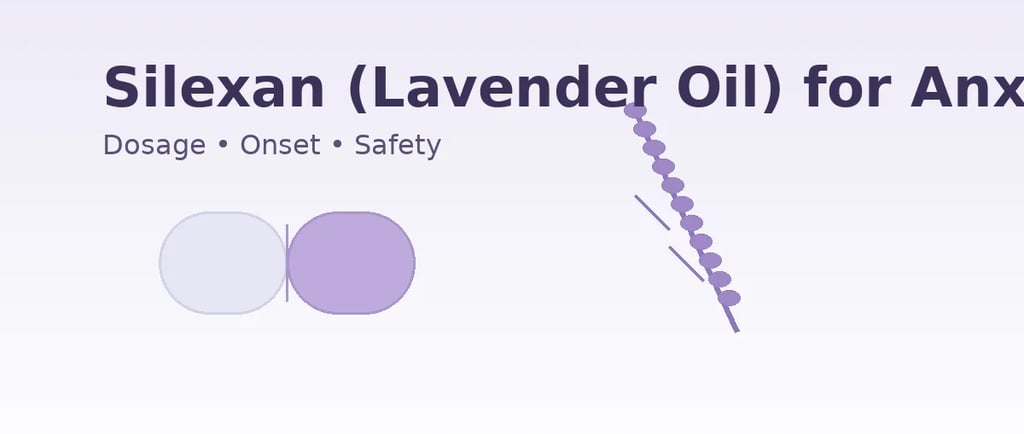Silexan for Anxiety: Dosage, Onset & Safety
Evidence-backed guide to Silexan (lavender oil) for anxiety—dose (80–160 mg), how long it takes, side effects, and when to consider 160 mg. Includes FAQs and a step-by-step plan.
8/25/20252 min read


Affiliate disclosure: Some links below are affiliate links. If you buy through them, MindRestore may earn a small commission at no extra cost to you.
Silexan (Lavender Oil) for Anxiety: Dosage, Onset & Safety
Short version: Silexan is an oral lavender oil extract studied at 80–160 mg/day for anxiety. RCTs and a 2023 meta-analysis suggest small-to-moderate reductions in anxiety symptoms with good tolerability; most people notice changes in 1–2 weeks, with clearer benefits by 4–8 weeks. Not sedating. Mild GI effects (e.g., burping) are the most common side effects. SpringerLinkOxford AcademicEurope PMC
What is Silexan?
Silexan® is a standardized Lavandula angustifolia oil preparation taken as a softgel (not an aromatherapy oil). Trials have tested 80 mg and 160 mg once daily for generalized or subthreshold anxiety. Europe PMCSpringerLink
Does it work?
Multiple randomized, double-blind trials report that Silexan reduces anxiety symptoms vs placebo, including a 539-participant GAD study comparing 80 mg or 160 mg to placebo and to 20 mg paroxetine over 10 weeks. A 2023 meta-analysis of five RCTs found overall efficacy with good tolerability. Europe PMCOxford AcademicSpringerLink
How long until you feel it?
Most users notice early changes by week 1–2, with clearer effects by week 4–8 in trials. Stay consistent for at least 8–10 weeks before judging. SpringerLink
Dosage & how to take it
Standard dose: 80 mg once daily with water.
Higher severity: some trials used 160 mg once daily.
Timing: morning or early evening; consistency matters more than clock time.
With/without food: either is fine; food may reduce burping. Europe PMCSpringerLink
Copy-paste friendly purchase line (text first, then URL):
Try Silexan Today!
Side effects & who should avoid it
Generally well-tolerated; the most common issues are mild GI symptoms (e.g., eructation/burping, nausea) and lavender breath/aftertaste. Avoid if you’re pregnant/breastfeeding (insufficient data) and check with your clinician if you use CNS sedatives or have complex medication regimens. ScienceDirectSpringerLink
How Silexan compares
Unlike sedatives, Silexan has no known dependence and is non-sedating. It’s often considered when people want a gentler, evidence-backed option before or alongside therapy and lifestyle changes. In the head-to-head GAD trial, symptom reduction with 160 mg was comparable to paroxetine 20 mg on primary outcomes, with favorable tolerability. Europe PMC
Exactly how to use Silexan (step-by-step)
Pick a starting dose: 80 mg once daily.
Take it daily at the same time for 2 weeks.
Assess at week 4: If symptoms remain high, discuss 160 mg with your clinician.
Track a simple score (e.g., 0–10 anxiety, sleep) 3–4 times/week.
Re-evaluate at week 8–10 before deciding to continue or switch. SpringerLink
Evidence & citations (key sources)
2014 RCT (539 participants): Silexan 80/160 mg vs placebo & paroxetine in GAD (10 weeks). Europe PMCResearchGate
2010 RCT: Silexan effective in subsyndromal anxiety vs placebo. Internet Archive
2023 meta-analysis (5 RCTs): Overall anxiolytic efficacy and good tolerability. SpringerLink
Conclusion (CTA)
If you’re seeking a non-sedating, evidence-backed option, consider Silexan 80 mg daily for 8–10 weeks, adjusting to 160 mg if needed (with clinician input). Track your progress, and build fundamentals (sleep, movement, therapy) around it.
Try Silexan Today!
Trust the science
Natural supplements backed by clinical research.
support@mindrestore.org
© 2025. All rights reserved.